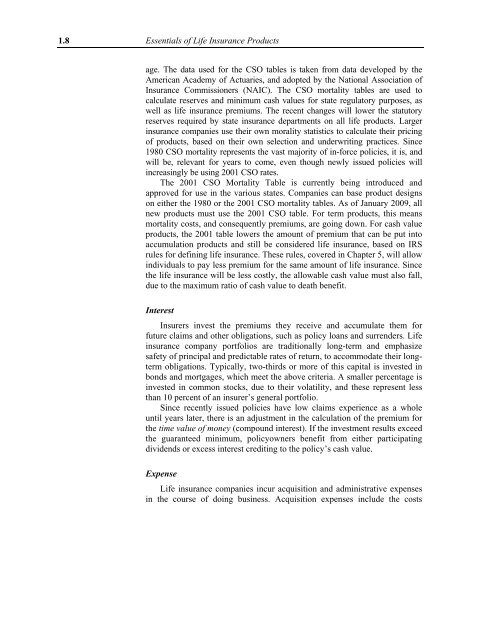Basic Principles of Life Insurance - The American College
Basic Principles of Life Insurance - The American College
Basic Principles of Life Insurance - The American College
You also want an ePaper? Increase the reach of your titles
YUMPU automatically turns print PDFs into web optimized ePapers that Google loves.
1.8 Essentials <strong>of</strong> <strong>Life</strong> <strong>Insurance</strong> Products<br />
age. <strong>The</strong> data used for the CSO tables is taken from data developed by the<br />
<strong>American</strong> Academy <strong>of</strong> Actuaries, and adopted by the National Association <strong>of</strong><br />
<strong>Insurance</strong> Commissioners (NAIC). <strong>The</strong> CSO mortality tables are used to<br />
calculate reserves and minimum cash values for state regulatory purposes, as<br />
well as life insurance premiums. <strong>The</strong> recent changes will lower the statutory<br />
reserves required by state insurance departments on all life products. Larger<br />
insurance companies use their own morality statistics to calculate their pricing<br />
<strong>of</strong> products, based on their own selection and underwriting practices. Since<br />
1980 CSO mortality represents the vast majority <strong>of</strong> in-force policies, it is, and<br />
will be, relevant for years to come, even though newly issued policies will<br />
increasingly be using 2001 CSO rates.<br />
<strong>The</strong> 2001 CSO Mortality Table is currently being introduced and<br />
approved for use in the various states. Companies can base product designs<br />
on either the 1980 or the 2001 CSO mortality tables. As <strong>of</strong> January 2009, all<br />
new products must use the 2001 CSO table. For term products, this means<br />
mortality costs, and consequently premiums, are going down. For cash value<br />
products, the 2001 table lowers the amount <strong>of</strong> premium that can be put into<br />
accumulation products and still be considered life insurance, based on IRS<br />
rules for defining life insurance. <strong>The</strong>se rules, covered in Chapter 5, will allow<br />
individuals to pay less premium for the same amount <strong>of</strong> life insurance. Since<br />
the life insurance will be less costly, the allowable cash value must also fall,<br />
due to the maximum ratio <strong>of</strong> cash value to death benefit.<br />
Interest<br />
Insurers invest the premiums they receive and accumulate them for<br />
future claims and other obligations, such as policy loans and surrenders. <strong>Life</strong><br />
insurance company portfolios are traditionally long-term and emphasize<br />
safety <strong>of</strong> principal and predictable rates <strong>of</strong> return, to accommodate their longterm<br />
obligations. Typically, two-thirds or more <strong>of</strong> this capital is invested in<br />
bonds and mortgages, which meet the above criteria. A smaller percentage is<br />
invested in common stocks, due to their volatility, and these represent less<br />
than 10 percent <strong>of</strong> an insurer’s general portfolio.<br />
Since recently issued policies have low claims experience as a whole<br />
until years later, there is an adjustment in the calculation <strong>of</strong> the premium for<br />
the time value <strong>of</strong> money (compound interest). If the investment results exceed<br />
the guaranteed minimum, policyowners benefit from either participating<br />
dividends or excess interest crediting to the policy’s cash value.<br />
Expense<br />
<strong>Life</strong> insurance companies incur acquisition and administrative expenses<br />
in the course <strong>of</strong> doing business. Acquisition expenses include the costs
















